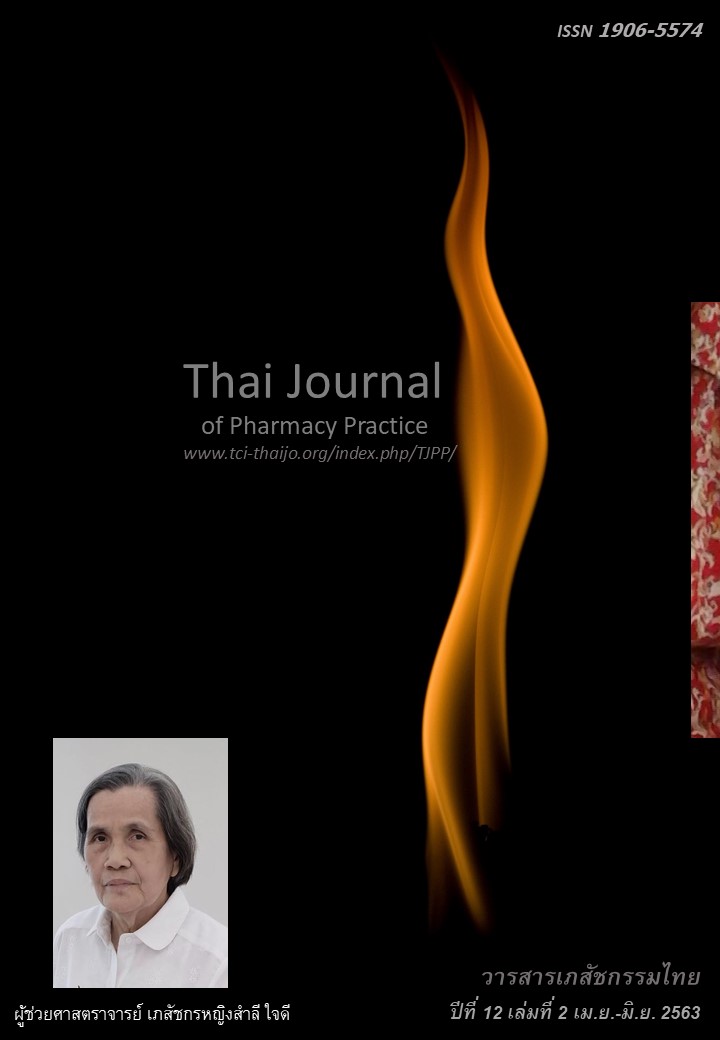การสร้างและทดสอบแบบประเมินการทำงานของมือฉบับภาษาไทยด้วยราสซ์โมเดล
Main Article Content
บทคัดย่อ
วัตถุประสงค์: เพื่อสร้างและทดสอบแบบประเมินการทำงานของมือฉบับภาษาไทย วิธีการ: แบบประเมินฉบับร่างสร้างขึ้นจากแบบสอบถามบริเวณมือฉบับภาษาไทยและต่างประเทศ ตลอดจนการสัมภาษณ์นักกายภาพบำบัดและนักกิจกรรมบำบัด จากนั้นตรวจสอบความตรงเชิงเนื้อหาโดยผู้เชี่ยวชาญ 3 ท่าน พบดัชนีความสอดคล้องของข้อคำถามกับวัตถุประสงค์มีค่าอยู่ระหว่าง 0.67-1.00 แบบประเมินฉบับสุดท้ายมีคำถาม 33 ข้อ บนมาตรวัด 5 ระดับ จากนั้นเก็บข้อมูลด้วยแบบประเมินในผู้ป่วยจำนวน 180 ราย จากแผนกกายภาพบำบัดของ 10 โรงพยาบาล วิเคราะห์ข้อมูลโดยใช้ราสซ์โมเดล ผลการวิจัย: แบบประเมินที่สร้างมีความเป็นเอกมิติจากค่าความแปรปรวนที่อธิบายได้จากโมเดลการวัด (มีค่าร้อยละ 54.96) และความแปรปรวนขององค์ประกอบแรกของส่วนเหลือ (มีค่าร้อยละ 3.61) มีค่ามากกว่าร้อยละ 40 และน้อยกว่าร้อยละ 15 ตามลำดับ คำถามทุกข้อมีความเป็นอิสระของข้อคำถาม โดย person reliability และ person separation มีค่า 0.93 และ 3.59 ตามลำดับ ส่วนค่า item reliability และ item separation มีค่า 0.95 และ 4.29 ซึ่งทุกค่าอยู่ในเกณฑ์เป็นที่ยอมรับ การทดสอบความเหมาะสมรายข้อ พบว่า คำถามทั้ง 33 ข้อ มีค่า infit mean-squares และค่า outfit mean-squares อยู่ในเกณฑ์เหมาะสมซึ่งอยู่ระหว่าง 0.50-1.50 ยกเว้นข้อคำถามที่ 18 มีค่า outfit mean-squares เท่ากับ 1.53 หลังจากปรับปรุงตัวเลือกเหลือ 3 รายการคำตอบและตัดกลุ่มตัวอย่างที่ไม่เหมาะกับราสซ์โมเดลจำนวน 29 ราย แล้วทดสอบความเหมาะสมรายข้อ พบว่าคำถามทั้ง 33 ข้อ มีค่า infit mean-squares และค่า outfit mean-squares อยู่ในเกณฑ์เหมาะสม ข้อคำถามมีระดับความยากไม่กระจายตัวเมื่อเทียบกับการกระจายตัวของระดับความสามารถในการทำงานของมือของกลุ่มตัวอย่าง โดยพบว่าตัวอย่างส่วนหนึ่งมีความสามารถในการทำงานของมือน้อยกว่าข้อคำถามที่ง่ายที่สุด และตัวอย่างอีกส่วนหนึ่งมีระดับความสามารถในการทำงานของมือมากกว่าข้อคำถามที่ยากที่สุด โดยข้อคำถามมีระดับความยากระหว่าง -1.19 ถึง 1.55 logits ในขณะที่คะแนนระดับความสามารถในการทำงานของมือระหว่าง -6.62 ถึง 5.12 logits สรุป: แบบประเมินการทำงานของมือฉบับภาษาไทยมีความเป็นเอกมิติและความเป็นอิสระของข้อคำถาม มีความตรงและความเที่ยงที่ดี แต่ในการศึกษาครั้งต่อไปควรเพิ่มข้อคำถามที่วัดระดับการทำงานของมือทั้งระดับยากและง่ายขึ้นกว่าเดิมเพื่อให้ครอบคลุมระดับความสามารถในการทำงานของมือของกลุ่มตัวอย่าง
Article Details
ผลการวิจัยและความคิดเห็นที่ปรากฏในบทความถือเป็นความคิดเห็นและอยู่ในความรับผิดชอบของผู้นิพนธ์ มิใช่ความเห็นหรือความรับผิดชอบของกองบรรณาธิการ หรือคณะเภสัชศาสตร์ มหาวิทยาลัยสงขลานครินทร์ ทั้งนี้ไม่รวมความผิดพลาดอันเกิดจากการพิมพ์ บทความที่ได้รับการเผยแพร่โดยวารสารเภสัชกรรมไทยถือเป็นสิทธิ์ของวารสารฯ
เอกสารอ้างอิง
2. Vincent JI, MacDermid JC, King GJ, Grewal R. Rasch analysis of the Patient Rated Elbow Evaluation questionnaire. Health Qual Life Outcomes 2015; 13 : 2-13.
3. Phongamwong C, Choosakde A. Reliability and validity of the Thai version of the Shoulder Pain and Disability Index (Thai SPADI). Health Qual Life Outcomes 2015; 13: 2-4.
4. Prior Y, Tennant A, Tyson S, Kjeken L, Hammond A. Measure of activity performance of the hand (MAP-Hand) questionnaire: linguistic validation, cultural adaptation and psychometric testing in people with rheumatoid arthritis in the UK. BMC Musculoske letal Disorders 2018; 19: 1-12.
5. Rosales RS, Hidalgo YM, Morales LR, Atroshi I. Reliability and construct validity of the Spanish version of the 6-item CTS symptoms scale for outcomes assessment in carpal tunnel syndrome. BMC Musculoskelet Disorder 2016; 17: 2-4.
6. John M, Angst F, Awiszus F, Pap G, MacDermid JC, Simmen BR. The Patient-Rated Wrist Evaluation (PRWE): cross-cultural adaptation into German and evaluation of its psychometric properties. Clin Exp Rheumatol 2008; 26: 1047-58.
7. Beirer M, Serly J, Vester H, Pförringer D, Crönlein M, Deiler S, et al. The Munich Wrist Questionnaire (MWQ)–development and validation of a new patient-reported outcome measurement tool for wrist disorders. BMC Musculoskelet Disord 2016; 17: 1-8.
8. Rapipong J. Disabilities of the Arm, Shoulder and Hand (DASH) Thai version [online]. 2006 [cited May 13, 2019]. Available from: www.dash.iwh.on.ca/site s/dash/public/ translations/DASH_Thai.pdf.
9. Upatham S, Kumnerddee W. Reliability of Thai Ver sion Boston Questionnaire. J Med Assoc Thai 2008 ; 8: 1250-6.
10. Guntayoung C, Chinchai S. The content validity and test-retest reliability of the developmental visual perception test (DTVP-2) in Thai children. Int J Med Pharm Sci 2013; 3: 1-6.
11. Meijer RR, Sijtsma K. Methodology review: Evaluating person fit. Appl Psychol Meas 2001; 25: 107-35.
12. DeMars C. Measuring higher education outcomes with a multidimensional Rasch model. J Appl Meas 2004; 5: 350-61.
13. Linacre JM. Misfit diagnosis: Infit outfit mean-square standardized [online]. 2012 (cited May 7, 2019). Available from: www.winsteps.com/winman/diagno singmisfit.htm.
14. Linacre JM. Reliability and separation of measures [online]. 1999 [cited May 7, 2019]. Available from: www.winsteps.com/winman/reliability.htm.
15. Smith EV. Detecting and evaluating the impact of multidimensionality using item fit statistics and principal component analysis of residuals. J Appl Meas 2002; 3: 205-31.
16. Linacre JM. Data variance explained by Rasch measures. Rasch Measurement Transactions 2006 ; 20: 1045.
17. Embetson SE, Reise SP. Item response theory for psychologists. Mahwah: New Jersey, L. Erlbaum Associates, 2000.
18. Wang Z, Zhou J, Luo X, Xu Y, She X, Chen L, et al. Rasch analysis of the Adult Strabismus Quality of Life Questionnaire (AS-20) among Chinese adult patients with strabismus. PLOS ONE 2015; 10: e0142188. doi:10.1371/journal.pone.0142188.
19. Bond T, Fox C. Applying the Rasch model: Fundamental measurement in the human sciences. 2nd ed. Mahwah: Lawrence Erlbaum Associates; 2007


